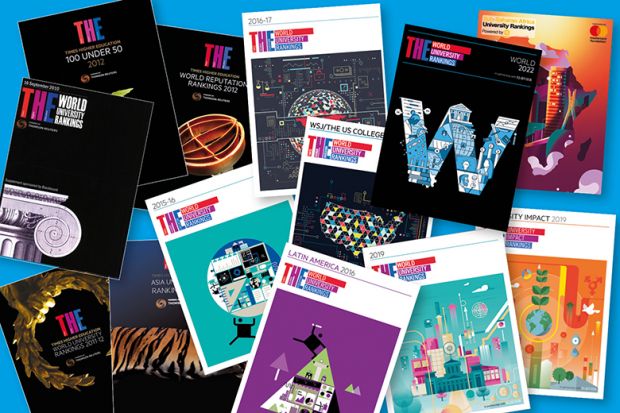Browse the full results of the World University Rankings 2024
“US dominates worldwide league tables.”
“West is best but there’s a rich feast in the East.”
These headlines from the first edition of the Times Higher Education World University Rankings in 2004 at once demonstrate how little and how much has changed in global higher education over the past 20 years.
At first glance, they are headlines that could have been written today – after all, the US is still the most-represented country in the ranking, both overall and in the top 200, and institutions in the West still fill the top 10 positions.
But the ranking has expanded from just 200 institutions in 2004 to more than 1,900 this year, meaning we now have a much more detailed picture of global higher education performance.
The US now accounts for only 9 per cent of institutions in the table; Asia has been the most-represented continent since the 2021 edition (overtaking Europe); and Africa and South America each have more than 100 universities represented. To say the US dominates would be a gross oversimplification.
But a comparison between the ranking now and 20 years ago tells us only so much. We’ve looked through the archives to pull out the most eye-catching stories from the rankings over the past two decades and explore what they tell us about the development of global higher education.
The rise of China
It is difficult to select just one data point summing up China’s extraordinary and consistent rise in the rankings. While Peking University ranked 17th in the world in the first edition of the table in 2004, only four others made the top 200 (the second highest was Tsinghua University in 62nd place). The 2023 edition features 11 Chinese institutions in the top 200, and four of those are in the top 60. Tsinghua is now the highest ranked among them, at 16th.
But perhaps the most striking development was in the 2020 edition, when China became home to the top two universities in Asia for the first time (previously Japan and then Singapore led the continent).
Chinese universities have been closing the gap with the US on citation impact since the 2018 edition, and in 2021 the research quality of the middle-ranking universities in the two countries – based on the number of citations achieved by the middle 50 per cent of ranked universities – began to converge for the first time. This meant that some middle-ranking Chinese universities were outperforming some middle-ranking US universities.
China’s median research income also overtook the US’ for the first time in 2021.
Meanwhile, the data we collect through our Academic Reputation Survey has revealed that international scholars in arts, humanities and social sciences are increasingly recognising Chinese institutions – a notable trend given that the rising global reputation of the country’s universities is usually attributed to its scientific prowess.
The Chinese government has consistently invested in higher education and research and development for more than two decades, with funding specifically targeted at developing world-class universities, training scholars at top institutions in the West and building capacity in China.
However, last year’s data suggest that internationalisation is a weak link for the Asian superpower.
Oxford becomes number one
The University of Oxford became the first UK university to top the THE World University Rankings in the 2017 edition – replacing the five-time leader, the California Institute of Technology, known in the US as Caltech – and it has been at the helm ever since.
Oxford’s rise that year was attributed to the fact that its total income and research income were rising faster than its staff numbers, its research was more influential, and it had been more successful at drawing in international talent.
Louise Richardson, who was then Oxford’s vice-chancellor, said at the time that the key factor was recruiting the best people.
“Any university is only as good as the academics it can attract,” she said.
“The best academics attract other top academics as well as smart early career academics. They attract the best students and the most competitive research funding, so it really is a virtuous circle. The key is for universities to provide an environment in which these academics are valued, in which young academics are supported and in which all are free to set their own research agendas.”
However, Harvard University has topped the World Reputation Rankings since they began in 2011 (despite not leading the World University Rankings since the 2011 edition), proving that prestige is both hard to win and difficult to shake.
While the UK is one of the top national performers in the ranking – it consistently has the second-highest representation in the top 200, and is the only country other than the US to regularly feature in the top 10 – it is not always plain sailing for the UK’s other institutions.
Analysis of the 2020 edition revealed that the funding gap between the UK sector and other major higher education systems was widening, leading to declines for many of the country’s leading universities.
The growing importance of internationalisation
The World University Rankings have always included metrics relating to international outlook, but these have expanded, while universities’ own data submissions reveal that institutions have become increasingly global.
The first edition of the ranking was based on just five performance indicators, two of which covered internationalisation: proportion of international staff and proportion of international students. The 2011 edition introduced a third measure on the share of internationally co-authored research.
There is now more student and academic mobility, and more cross-border research, than ever before. Data from the 2019 edition of the rankings showed that most countries had improved their average scores in the international outlook pillar when compared with the 2016 data.
Newer universities are particularly excelling in this regard. The world’s youngest universities outperform their older counterparts when it comes to attracting overseas students and publishing international research, according to data from the 2017 edition. This was backed up by data in 2019 showing that institutions set up since 2000 appear to have the biggest lead when it comes to researchers teaming up across borders.
The Middle East is a region to watch
The United Arab Emirates and Israel are both lurking just outside the top 200 of the latest World University Rankings, while Saudi Arabia's top institution joined this elite group in the 2022 edition.
Some of Israel's leading institutions have briefly featured in this club in previous years, but a key question is whether any of these nations can hold on to a spot in the upper echelons of the table amid growing global competition.
Data from the 2022 edition revealed that universities in Saudi Arabia and Egypt were the fastest-rising higher education institutions in the world, improving more quickly than those in mainland China. One of Saudi Arabia’s main goals in its Vision 2030 strategy is to have at least five universities in the top 200 in the world.
Another country to watch outside of the Middle East region is India. Its flagship, the Indian Institute of Science, ranks 201-250 this year (it last made that position in 2017). The country has hugely ambitious goals under its 2020 National Education Policy, including a new National Research Foundation, but whether the reforms take off remains to be seen.
A brief history of the Times Higher Education rankings
November 2004
The Times Higher Education Supplement (as it was then known) publishes the first edition of the World University Rankings, in partnership with Quacquarelli Symonds (QS), ranking 200 universities. The methodology was based on just five performance indicators: staff-to-student ratio, reputation of academics (based on a survey), research paper citations, proportion of international staff on campus and proportion of international students.
November 2009
Times Higher Education sets up a new partnership with Thomson Reuters to develop a more sophisticated ranking system. A new methodology using 13 separate indicators is devised, following a global opinion survey of higher education professionals and student consumers of rankings. It includes new metrics for teaching and knowledge transfer in addition to research excellence.
September 2010
The first THE World University Rankings, powered by Thomson Reuters, are published.
March 2011
The THE World Reputation Rankings – showing the results of the academic reputation survey in isolation from the other rankings indicators – are launched.
September 2011
The World University Rankings doubles in size, ranking 400 universities.
May 2012
THE launches the Young University Rankings, listing the top universities that are aged 50 years and under.
April 2013
The first Asia University Rankings are published.
November 2014
THE ends its partnership with Thomson Reuters and establishes a new collaboration with Elsevier as a bibliometric data supplier.
September 2015
The World University Rankings expands again, featuring 800 universities. All the core institutional and reputational data are gathered and managed in-house by THE’s team of data experts for the first time.
July 2016
The first Latin America University Rankings are published.
September 2016
The cap on the number of ranked institutions is removed, meaning that all eligible institutions that submit data are listed for the first time – a total of 981 universities. The methodology is further enhanced, with books and book chapters included among the research outputs evaluated (alongside journal articles, reviews and conference proceedings). The calculations are audited by PricewaterhouseCoopers.
October 2016
THE launches the teaching-focused US College Rankings, in partnership with The Wall Street Journal.
March 2017
THE launches the teaching-focused Japan University Rankings, in partnership with Benesse Corporation.
September 2017
More than 1,000 universities feature in the World University Rankings for the first time.
April 2019
The THE Impact Rankings, the only global performance tables that assess universities against the United Nations’ Sustainable Development Goals, are launched.
July 2021
THE releases the first Arab University Rankings.
September 2021
For the first time, universities that submit data but do not meet the eligibility criteria to receive a rank are listed as “reporter’” institutions, bringing the total number of universities in the table to over 2,000.
April 2023
THE announces the new World University Rankings methodology (WUR 3.0), featuring 18 performance indicators – including three new metrics on citations and one new metric on patents. Improvements are also made to the international outlook metric calculations.
June 2023
THE publishes the first Sub-Saharan Africa University Rankings, in partnership with Mastercard Foundation, in a project led by Ashesi University in Ghana. The rankings aim to assess the impact of universities in addressing some of the toughest challenges faced in the region.
Register to continue
Why register?
- Registration is free and only takes a moment
- Once registered, you can read 3 articles a month
- Sign up for our newsletter
Subscribe
Or subscribe for unlimited access to:
- Unlimited access to news, views, insights & reviews
- Digital editions
- Digital access to THE’s university and college rankings analysis
Already registered or a current subscriber?








